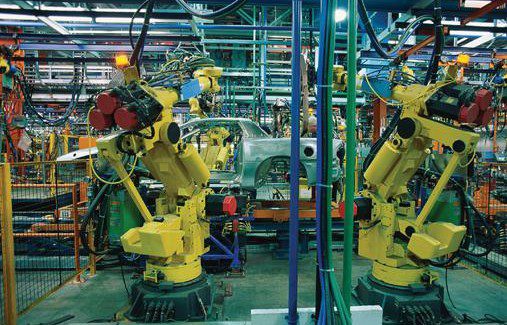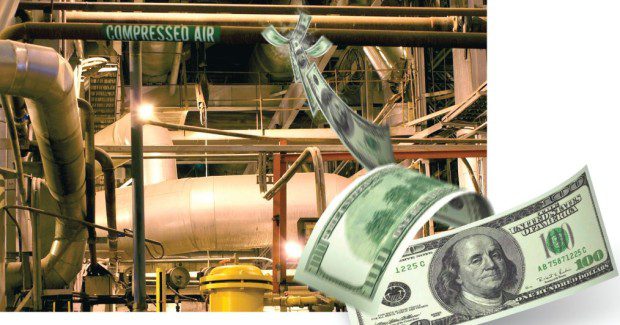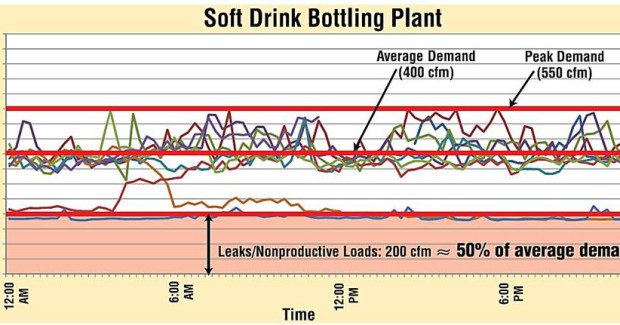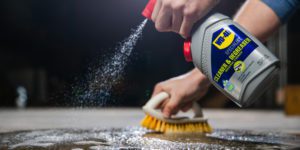The Cost, Common Culprits, Detection and Repair of Compressed Air System Leaks
An ongoing leak detection audit and repair program will quickly pay for itself through energy savings (and may even be subsidized by local utility incentive programs). Equally important, you will likely see benefits from reduced downtime and better running production equipment. All of these contribute to a stronger bottom line.
Posted: April 21, 2014
LEAK DETECTION METHODS
Too many users simply accept leaks as an unavoidable aspect of compressed air, just a cost of doing business. While it may not be practical to eliminate all leaks, it is not difficult to greatly reduce them. First, you must find them. There are three common methods of leak detection: listening and feeling, the soapy water technique, and ultrasonic leak detection.
Listen and feel. A simple way to detect leaks is by listening for and then feeling leaks. This is only effective for large leaks that you can get close enough to touch. Plus you must be able to hear them above the noise of plant equipment. This technique will not work for most leaks.
Soapy water. Another leak detection method is the soapy water method. Soapy water is applied with a brush to areas where a leak is suspected. If a leak is present, soap bubbles will form. Although reliable, it is time consuming, and requires direct physical access to the entire piping system. Leaks in overhead piping or in hard-to-access areas may not be detected.
Further, this method does not provide information on the relative volume of each leak, leaving the user ill informed about which leaks are wasting the most air.
Ultrasonic. The industry standard and best practice is to use ultrasonic leak detection. This is the most versatile form of leak detection and can detect leaks as small as a pinhole. It’s both fast and accurate. Plus, it does not require plant downtime to conduct a leak detection audit, because background noise does not interfere with its results.
Unlike the first two methods, it can be done without physical contact with the leaks. This method works because when compressed air is released into the atmosphere, the turbulence creates ultrasonic noise inaudible to the human ear but detectable with the right equipment. Ultrasonic leak detection equipment typically consists of directional microphones, amplifiers and audio filters, and usually has either visual indicators or earphones to help the auditor identify the leaks.
Since ultrasonic is a high frequency signal, the sound from a compressed air leak is both directional and localized to the source. This allows the ultrasonic detector to sense the leak in loud, noisy environments and locate the source of the leak. Some ultrasonic leak detection devices are also able to estimate and record the volume of leakage based on the decibel level of the leak.
EXPECTATIONS OF AN ULTRASONIC LEAK AUDIT
Once the leaks are found, a smart practice is to tag each leak with a bright, durable tag to make finding the leaks easy when it comes time for repairs. We recommend that information on each uniquely identified leak should then be documented in a spreadsheet or other document that allows you to calculate leak costs and prioritize follow-on action. Some vendors offer spreadsheet tools with this capability.
As shown above, energy costs from leaks can be calculated with the following formula:
Annual cost of leaks = Leakage rate (cfm) x kW/cfm x operating hours x $/kWh
Once the cost of each leak is determined, it should be easy to prioritize the most important leaks to fix first. A
good leak detection audit should:
- Clearly identify each leak with an easily recognized tag that includes the date and a unique identifying code/number.
- Provide a list of leaks with their locations, unique identifier and severity.
- Estimate the cost/potential savings of each leak and enable you to sort the list by leak severity.
FIX THE LEAKS
The leak detection audit creates your action plan, but it is the repairs that will actually create the cost savings. This may seem obvious; however, all too often plants conduct or pay for a leak study and do little with it. Without the follow-up, the leak detection is just another cost. Your goal is to reduce total leakage to less than ten percent of your total compressed air production. The good news is that the Pareto Principle (80–20 rule) applies: even just fixing the top 20 percent of the leaks can reduce the total compressed air leakage by 80 percent or more. Start with the big leaks first. Repair main-system leaks during scheduled downtime. If an area can be bypassed during a repair, downtime isn’t necessary.
DEVELOP AN ONGOING PROGRAM
It’s important to recognize that leak detection and repair is an ongoing program. It will never be “one and done.” As a system ages or is changed, new leaks can occur in areas throughout the system, or previously repaired leaks may need further attention. Having a leak detection audit performed every 6 to 12 months as part of your ongoing efforts will keep you focused on the biggest leaks.
Work with whoever performs your leak detection audit to determine the best frequency of future audits for your plant. He or she can help you establish a program that continues to maximize plant productivity and profits through leak detection and repair. Plant employees also play an important role in your leak detection and repair program. In many cases, even when the audit is contracted out, the repairs are assigned to plant staff. But even if an outside party handles the repairs, employees at all levels should be educated and encouraged to report leaks as they detect them.
Oftentimes, employees may be aware of leaks but do not realize the financial impact of the leaks. Overall profitability should be everyone’s concern, so underscoring the benefits of eliminating leaks and dedicating resources to the task is critical.
CONCLUSION
Like a furnace that heats a home that’s well insulated, a compressed air system with a minimum amount of leaks is more energy efficient and more effective. Leak reduction is one of the most cost-effective steps a plant can take to immediately reduce energy costs and improve profitability. Leak reduction also directly supports your company’s goal to reduce its carbon footprint.
An ongoing leak detection audit and repair program will quickly pay for itself through energy savings (and may even be subsidized by local utility incentive programs). Equally important, you will likely see benefits from reduced downtime and better running production equipment. All of these contribute to a stronger bottom line.












